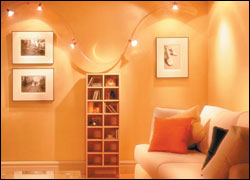Track lighting makes it easy to highlight your favorite painting, provide greater visibility in the kitchen or add depth and dimension to any room. It's an ideal choice when you don't have the space for another decorative fixture or you simply want to provide light from a different angle. Track lighting provides a great deal of flexibility and is easy to install. Kits provide all of the parts and pieces you need for installation, though you can also choose to purchase lights, mounts and power sources separately. Prior to jumping into the task of putting in track lighting, consider these questions:
What purpose will the track lighting serve?
Where will you install the lights?
Will you power the track with a junction box or standard outlet?
Would you prefer line-voltage or low-voltage tracks?
What parts and accessories will you need for successful installation?

Purpose and Installation Considerations
The primary decisions you'll need to make when installing track lighting are what it will be used for and where it will be installed. General use, accent lighting, wall washing and task lighting all require different placements. Each technique is appropriate for nearly any room, so once you select an area, the most important decision will be where you place the lights. Several components are necessary to make track lighting operate properly, including a track, connectors and a power source. You'll also want to be aware that there are different track standards and, once one is chosen, you'll need to purchase fixtures and accessories that fit that particular standard.
Ambient/General Lighting: While track lighting is not commonly used to provide general lighting in rooms, it does provide a comfortable level of brightness, enabling you to move about safely. Kitchens and entryways are good places to utilize track lighting for ambient light purposes, and you could install more than one set of track lights to provide ample light for larger rooms.
Use track lights to provide ambient lighting in smaller rooms
Multiple tracks allow you to cover a large area for general lighting
Accent and Wall Wash: Use track lighting to accent a picture on the wall, a bookcase or any other feature you'd like to highlight. Because track lighting is easy to angle, you'll have no problem spotlighting the chosen object no matter how high up or close to the ground it is. You won't need to do any remodeling to install track lighting, so you can rearrange your living room as many times as you like and easily put in track lighting to highlight your favorite objects wherever they come to rest. Wall washing is used to illuminate a series of pictures or wall hangings by directing multiple recessed fixtures toward a wall, an ideal solution when you want to feature a group of pictures or other decoration without providing a focus that is too specific.
Accent lighting provides higher intensity light than surrounding illumination
Angle lights at approximately 30° to minimize glare and reflection
Wall washing makes rooms appear larger, lighter and more airy
Task Lighting: Task lighting assists you in performing various activities, such as cooking or reading. Using track lights for task lighting gives you the ability to supplement overhead ambient light in areas where it is most needed, such as near a chair in a living room, over an island in a kitchen or above a computer in a study or home office. Adding track lighting to a finished basement can help create an ideal work space for writing, drafting or keeping track of household expenses. Using track lighting to brighten these areas rather than adding more general overhead lighting can lead to better energy efficiency.
Task lighting illuminates small areas in which activities are performed
Track lights focus light in heavily used areas for greater efficiency
Installation Considerations: There are multiple track types, and because not all fixtures fit each type of track, you'll want to purchase fixtures and accessories that conform to the same standard. You can choose to power your track lighting in one of two ways, through a junction box in the ceiling or through a standard outlet. You can also select either line-voltage or low-voltage track fixtures. Line-voltage operates at a standard 120V current while low-voltage tracks use a transformer to convert current to 12V. Low-voltage fixtures require a larger up-front investment but are generally more cost effective in the long run.
Junction boxes may require professional installation
Use a floating-canopy connector with a junction box for power along the track's length
Use a live-end connector with a junction box if you need power at the end of the track
Cord-and-plug connectors allow you to connect to a standard outlet
The number of fixtures you can use is determined by the total wattage of the fixtures
Features
Dimmer Switches: Lights with dimmer switches enable you to customize the level of light you need. You can adjust lights up or down with a handy wall switch until you find the perfect setting for performing a task or setting the mood.
Track Suspension Kit: If you have a loft or high ceiling, a suspension kit will enable you to hang track lights from the ceiling to bring the light source closer for more effective illumination.
Connectors: Connectors enable you to join straight track lengths to form various configurations, such as X, T and L, with a single power source, giving you the ability to choose the best setup for your lights given where you're installing them and what their primary purpose is. Different types include floating, live-end and cord-and-plug connectors.
Lenses: Use special lenses to alter the shape and color of light to create unique effects.





